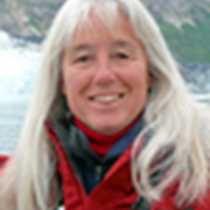Glacier Bay National Park
Last evening the National Geographic Sea Bird paused outside of the town of Gustavus and sent a Zodiac to pick up National Park Service Ranger/Naturalist Sierra Willoughby. He joined us to relate the story of dramatic ice retreat and subsequent succession of flora and fauna back to the land following the Little Ice Age. At midnight our permit became valid and we entered Glacier Bay National Park. In the morning, we found ourselves at the end of Tarr Inlet beside the towering face of Margerie and the rock concealed Grand Pacific Glaciers. We yawned and stretched while the glaciers cracked and groaned, releasing their frozen joints. A murky meltwater stream roiled up from below the waterline and black-legged kittiwakes streamed back and forth between their nesting cliff and the glacier face, where they fed on morsels stirred up to the surface.
In Johns Hopkins Inlet, we rounded Jaw Point to behold Johns Hopkins Glacier and the surrounding scene. A clear path led us to a safe distance from the face of this tremendous glacier, one of just a few in Alaska that is advancing. A large calving event drew our attention to the right side of the glacier (from our perspective), where we noticed hundreds of harbor seals resting on icebergs. On the way out of the inlet we stopped by the lovely blue Lamplugh Glacier, where we marveled at water gushing through a tunnel in the ice face.
We worked our way back down the bay, poking into various inlets to search for wildlife. A brown bear with a reddish coat was spotted walking along the shore. People temporarily abandoned their lunch to get a look before it disappeared into the bushes.
At the gray dolomitic rock outcropping known as Gloomy Knob, we spied seven mountain goats laying along ledges on the cliffs above the water, including a nanny with her kid, each with one leg hanging over the ledge. Sharp eyes also found a black hoary marmot running around on the rocks.
While transiting across the bay, Ranger Sierra gave a presentation entitled “Rock, Ice and People: The Changing Faces of Glacier Bay”, discussing the constant changes – past, present and future – of this dynamic place.
At South Marble Island, Steller sea lions and nesting seabirds spend the summer. The season is winding down but there was still plenty of activity amongst the tufted puffins, black-legged kittiwakes, pelagic cormorants and glaucous-winged gulls. A single California sea lion could be heard barking between the growls of its larger relatives.
Continuing to the Boulder Islands, more furry critters were found. Sea otters are a relative new-comer to Glacier Bay but they seem to be happy and proliferating here. We were delighted to see a large raft with individuals floating on their back, head and feet out of the water.
During recap some of the young people on board were rewarded for their hard work by earning Junior Ranger status. They proudly took the pledge and were presented with their badges by Ranger Sierra. To round out the day, the National Geographic Sea Bird docked in Bartlett Cove and we had an opportunity to stretch our legs on the trails or road and visit the lodge’s gift shop and display area. We were satisfied by a fulfilling day and a humble appreciation for the remarkable and dramatic place known as Glacier Bay National Park.




